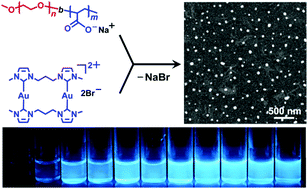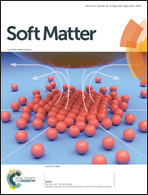Intensely phosphorescent block copolymer micelles containing gold(i) complexes†
Abstract
The electrostatic combination of anionic block copolymers with cationic gold(I) complexes leads to the formation of spherical micelles, where gold(I)-containing ionic cores were formed with anionic blocks and further stabilized by neutral blocks of polystyrene or poly(ethylene oxide). This self-assembled strategy induces remarkable phosphorescence enhancement of the gold(I) complexes in solution. The emissive intensity increases unexpectedly with increasing molecular weight of the anionic block that is not coordinated onto the gold(I) complexes. The intensely phosphorescent micelles formed in water can be utilized as a luminescence bioimaging probe in living cells.



 Please wait while we load your content...
Please wait while we load your content...